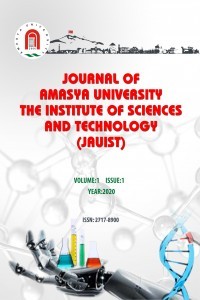DEVELOPMENT OF PULP AND PAPER USING STEM AND FRUIT STEM OF MUSA SPECIES
DEVELOPMENT OF PULP AND PAPER USING STEM AND FRUIT STEM OF MUSA SPECIES
impregnating temperature, bleached, pulp, pressurized, tearing resistance tensile strength,
___
- [1] J.U. Odo, E.L.C. Nnabuife, A.B. Ukaegbu. Production of paper from rice straw. Department of Metallurgical and Materials Engineering, Nnamdi Azikiwe University Awka Anambra State Nigeria. The Nigerian Materials Congress, NIMACON) (2004)39 - 41.
- [2] M. A. Omotoso, B. O. Ogunsile.Fibre and Chemical Properties of some Nigerian Grown Musa Species for Pulp Production. Department of Chemistry, Faculty of Science, University of Ibadan. Asian Journal of Materials Science, 2(3) (2010)160-167
- [3] O.E. Onuorah. Preliminary Investigation of the Potential of six Nigerian Grown Hardwood Species as sources of fiber for the Pulp and Paper Industry. Journal of Agricultural Technology (JAT), (2001).
- [4] K. Anya, K. Teschke. Fibre Sources for pulp and paper. Encyclopaedia of Occupation and Safety. International Labour Organization Geneva, (2011). http://www.ilo.org/oshenc/part-x/paper-and-pulpindustry. 4:15 PM 24/4/2013
- [5] H. Ibrahim, I.M. Bugaje, I.A Mohammed. Utilization of Bagasse as Raw Material for the production of pulp and paper in Nigeria. Chemical Engineering. International Journal of Engineering and Mathematical Intelligence, 2(1-3) (2011)26 -33
- [6] B. U. Anyanwu, O. S. Olokode, P.O. Aiyedun, F.T. Owoeye, Y.T. Oyeleke. Potentials of Ukwa Tree (Sterculia setigera) as a Source of Raw Material for Pulp and Paper Making. The Pacific Journal of Science and Technology,13(1) (2012)145-159.
- [7] N. K. Agarwal, N. K. Khanna, S. K. Chechi, K. L. Patel, S. L. Pawar, R .G. Patil. Evaluation of Banana Pseudostem Based on Fiber as Pulp and Paper Making Raw Material. Soil and Water Management Research Unit, Navsari Agricultural University Navsari, (Gujarat). IPPTA J. 23(3) (2011)119-125.
- [8] J. Christopher, HandBook of Pulp and Paper Making. Academic press San Diego, 2007. ISBN 0-12-097360-8
- [9] E. Sjostrom, Wood Chemistry: Fundamental and Application Academic Press San Diego, (2003)12-62. [10] M. Hartsuch, J. Paul. Chemistry for the Graphic Arts. Pennsylvania Graphic ArtsTechnical Foundation, (2003)196-214.
- [11] P. Froass, R. Arthur, J. Jiang. Chemical Structure of residual Lignin from Kraft Pulp. Journal of wood chemistry and Technology, 16(4) (2000)347-365.
- [12] H. Jeffery, S. Smith, B. Jason. Second Critical Solids Black Liquor Scalling Pulp and Paper. Engineering School of Chemical Engineering Georgia institute of Technology Georgia USA, (2007)34-60.
- [13] G. Astrakianakis, J. Anderson. Bleaching. Encyclopaedia of Occupation and Safety; International Labour Organization Geneva (2011). http://www.ilo.org/oshenc/part-x/paper-and-pulpindustry. 4:45PM 24/4/2013
- [14] P.P. Singh. The Bleaching of Pulp. 3rd Ed. TAPPI Press Atlanta USA, (2007) 45- 65.
- [15] G. Chuck. Paper and Pulp Dictionary CPPN Electronics 23 Mary Vale Drive, Webster NewYork, (2011).
- [16] M. A. Hubbe, Properties of Paper Department Wood and Paper Science. North Carolina State University USA, (2013).
- ISSN: 2717-8900
- Yayın Aralığı: Yılda 2 Sayı
- Başlangıç: 2020
- Yayıncı: Amasya Üniversitesi
DEVELOPMENT OF PULP AND PAPER USING STEM AND FRUIT STEM OF MUSA SPECIES
A CONTRIBUTION TO COMPLEMENTARY SOFT BINARY PIECEWISE PLUS AND Γ OPERATIONS
Coherent hybrid block method for approximating fourth order ordinary differential equations
Faruk MURİTALA, Abdulazeez Kayode JİMOH, Muideen OGUNNİRAN, Abdulmalik OYEDEJİ, Jafaar LAWAL
NORMAL PARACONTACT METRİC SPACE FORM ON W_0- CURVATURE TENSOR
